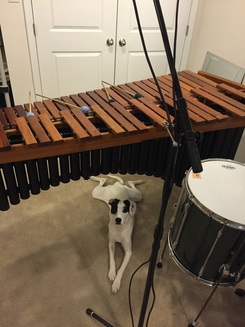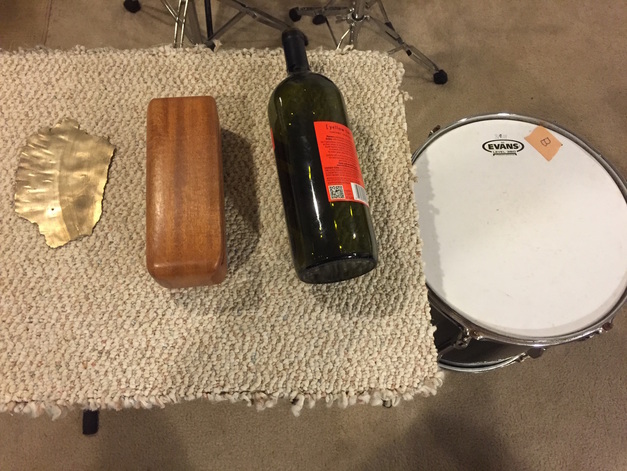 Post three! I hope you are ready!! This post will be guided mostly by playing examples, and of course focus on keyboard instruments. Even though I am mostly using marimba and some glockenspiel, you can apply these concepts to any pitched instrument you choose. Improvising on a pitched instrument automatically has some limitations, especially to musicians with a trained ear. This is because whether we want to or not, we think about tonal music theory. My suggestion is to once again, just play. Don't focus on voice leading, proper harmonization, notes outside of the key and instead go with what sounds good to your ear. My intention with the videos in this post was to present you all with music that is pleasing to listen to, yet within each I have still broken more rules than I can count! I treat composition in the same way. My musical training certainly influences what I write, but my ears- through experimenting with new sounds, textures, rhythmic/melodic development and feels- do most of the work. Otherwise, like a Theory 1 voice leading assignment, you can get so caught up in right and wrong that you may never unlock the creativity of what is really possible for you. As many musicians and composers have said before me...It's time to break the rules. (Note: breaking the rules also doesn't have to mean atonality) General Notes I like to come up with a theme or riff, whether melodic or rhythmic and play off of that first. Once an idea is in the air, I can come up with counterpoint and other development from that. This is when I definitely pull from my training. Although, sometimes even a dynamic scheme or mood you create can show what comes next. If you play a note that isn't in the key, challenge yourself to embrace the dissonance by playing it more than once, modulating to the key using that pitch, or by using it as a slight tension in the music that will redirect you back to where you began. As previously quoted in another post, "...there are no mistakes, just missed opportunities"! Below are things to try within common musical elements as you begin to improvise your own music on pitched instruments. You'll also be able to read about what I did for each video. Scales and Intervals Step 1- pick a scale or interval Step 2- try to modify the order of pitches as you play it (that includes repeating notes) Step 3- try focusing on one or two pitches (from the scale) only Step 4- if only using a couple of notes, experiment with rhythm or different sounds to spark new interesting aspects in your music Step 5- try using two completely different scales at once to create new layering effects and harmony 3d uses my favorite interval of a Major seventh as the thematic element. However, I used it in open (C-B) and closed (B-C) format to provide me with more sonic tools. This was intended to be harmonically static, so it naturally allowed me to use my snare drumming background to influence the rhythm and pump up the excitement. 3e is inspired by textures within Gordon Stout's beautiful piece for marimba, "Wood that Sings". I chose to use a softer mallet in my left hand to emphasize the two different voices moving about. Most of the music that I am playing is melody vs. accompaniment, but the roles constantly switch between the hands. The central scale is Bb Major, but I took the music into G minor and F minor as well before returning back to Bb Major in the end. 3f is a short clip that uses the interval of a minor second in the right hand to provide the melody. Yes, both notes are the melody in my mind! The left hand helps maintain structure for the large scale form and provides harmonic contrast between D minor and F Major (minus the b naturals: Lydian mode) Key or Chord Progression Step 1- come up with a chord progression prior or improvise this as well. Remember that it doesn't have to be a progression that follows the rules. Don't limit yourself. Use parallel chords, borrow or change the tonality altogether. You should even try using random chords and play chromatic lines over it or use a progression without common notes. (If you compose your progression first, it may be a good idea to have a small whiteboard handy to write it on.) Step2- create a melody over it... or don't In 3a and 3c, I chose to experiment with EMaj7 and C#-7 as my chord sequence. So, much of the melodic content came from improvising over an E Lydian scale due to all of the common notes (the A# over E just adds a color that I like). I was into the sound of #4 that day, I guess. Oh, wait that's every day... 3a has more of a symmetrical chord structure in the beginning, but there are times where I borrowed chords due to unplanned notes that I hit. For instance, at some point I hit a D within E major, so that made me want to modulate into the parallel key of D major. I also modulate into an F- and Db Maj segment around the 1 minute mark for contrast. Again, that was unplanned and has nothing to do with E Maj. However, that journey is significant because I took a risk and liked the result. I allowed the music to reach me before making a decision by comparing it to basic music theory. That is the beauty of organic music making. Play what sounds good to you and if you try something and it doesn't, don't do it again! In 3c, I did not try to keep to any particular form or texture. I wanted to have the glockenspiel and marimba interweaving throughout, but there are also times where it is melody vs. accompaniment. I'd also like to highlight my advanced video effect skills in the beginning of this one...haha Thank you to Shannon Wood and MalletShop for making it easy to obtain this beautiful set of roundtops and the guys at Century Mallet for your amazing work! I love this instrument!! Alternative Sounds Here are some techniques to consider while you play: -deadstrokes -playing on nodes -rolls -mallet/bowing options -multiple sound sources -rudiments -other instrument sounds made by frame, resonators, etc... -computer generated effects (to be covered in another post) Also, play off of what happens during other improvisations. 3b was created after making a "mistake" in one of my practice sessions. Note: I was using rattan mallets which have a little more rebound. While attempting a dead stroke, the mallet head slid off of the bar and the neck of the mallet hit the side of the same bar. This sound was interesting to me because you get both a slide sound that has a subtle pitch, the sharp click from the rattan against the bar, and the actual pitch of the bar! The sharpness of the click also inspired dead strokes, which then inspired playing on the nodes. All of those less resonant sounds then allowed the notes that I let ring "pop" much more than usual, which gave me a new textural perspective to work within. Do you see how active listening can inspire this domino effect of musical ideas? Use these ideas as a place to begin. The hope is that you will also come up with your own, which may lead to finding your voice as an artist and/or composer. Use the past to guide you, but create your own path!
Have you tried incorporating improvisation in your day yet? Share it with me! Happy practicing, Anthony
0 Comments
Ok everyone, this time I would like you to start by creating a non-pitched palette. Think about a painter. He or she begins with only a few colors, but once mixed there are many options. We can do the same thing, but actually dig even deeper since our “colors” often have more than one dimension. Try to diversify your sound sources as much as possible- in other words, your instruments should not all be made of the same material. I have chosen one drum, one wooden instrument and two metallic sounds. Experiment with each instrument and see what sounds are possible. Out of this set, I have come up with 11 or 12 independent sounds, but there will be more possibilities once mixed. There are even more possibilites when you consider mallet options. Feel free to go outside of conventional playing techniques and keep in mind that it is most difficult to express music on instruments that you don't practice every day, so don’t be afraid to just play around with "sounds" for a while. Once you have your palette and are ready to create some music, let’s add a bit of structure. If you've checked out my first post, you’ll remember the chart that I created to help you get started improvising. We will start there too. The following two performances are based around the same one-measure theme... However, I will vary each performance by experimenting with the style, texture, tempo and the sound choices I make. As always, headphones are recommended!! The next method of creation is through melodic development. You may simply choose a general direction of “pitch” and play around with that or you may try to create texture through playing counterpoint- melody vs. accompaniment. More ideas will continue to populate based on what you play ("momentary themes"). I also chose to swing this one! The last performance plays on melodic contour, but my main focus was experimenting with a faster tempo and rhythmic density. Think Moto Perpetuo... Now it's your turn. What will your palette look like? Please post pictures and especially videos to my social media, email me or leave a link to it in the comments!
|
AuthorAnthony Di Bartolo is a New Jersey-based percussionist, composer, and educator. Archives
June 2019
Categories |


 RSS Feed
RSS Feed